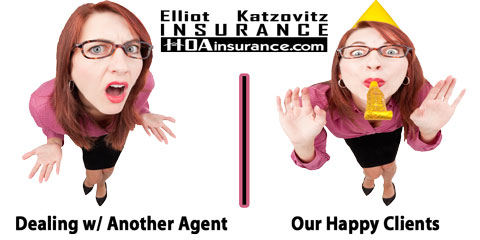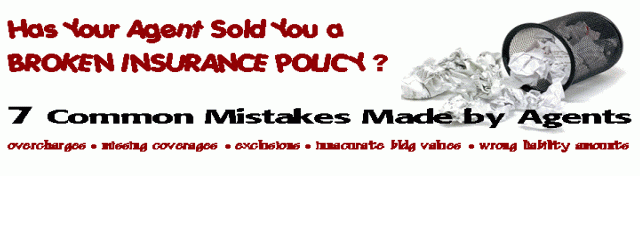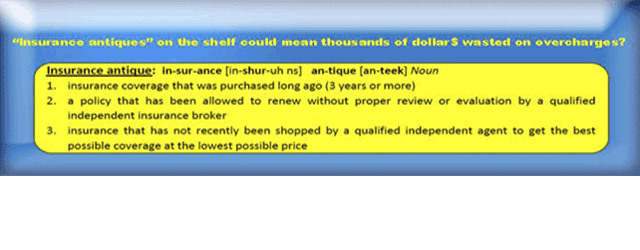One of the most common insurance problems I come across when doing risk evaluations for associations is a fatal gap in the Directors & Officers Liability coverage. What’s truly frightening is the fact that the board members I speak with often times had no idea that their personal assets have been at risk all along. The reason is that they do carry some type of D&O coverage in the form of either an insufficient add-on coverage or D&O endorsement provided with a package. Unfortunately for them, their current brokers failed to explain that as a board member they would have greater personal exposure due to the limitations and exclusions of their association’s insurance policy.
This very disturbing occurrence is not due to any sinister plot but rather;
1) Most agents don’t specialize at insuring condo associations and don’t really know how to properly insure an association
2) Many agents do not take the time to truly understand D&O insurance because it is not a big moneymaker like property and general liability
3) Agents with big captives like State Farm & Allstate etc. can only write their own D&O products no matter how inadequate they are for the client’s needs
4) Some agents try to make things “easier and more convenient” for the board by placing all insurance with one carrier, not understanding the limitations of the contract just sold
5) Some associations may try to save a few pennies by choosing an endorsement over a stand-alone policy costing just a little more money

Now that you know how insufficient coverage gets written in the first place, let me go over some specific holes in coverage that exist in a typical D&O add-on or endorsement.
HOLE #1 – Matters of Insurance Are Excluded
This exclusion is on each and every one of the Directors and Officers endorsements I’ve read. It’s important because it means that if the board gets sued for having failed to purchase enough coverage or the right coverage for the association, the board is not protected and will need to provide its own defense and settlement. The reason that this exclusion exists on the endorsement is because a carrier does not want to end up covering property or liability claims that it just got done denying on the property or G/L portion of the policy.
Here’s an example of how this happens. For instance, the sewer backs up into one of the units causing $30,000 in damage. It turns out that the policy either didn’t offer the coverage or it was left off to make the premium cheaper, and now there is a $30,000 uncovered claim. The unit owner that has sustained the damage sues the association for having failed to purchase necessary coverage. The company that just denied the sewer claim will now deny the defense for the lawsuit because matters of insurance are excluded.
Another common issue that comes up is that the unit interiors have been insured incorrectly, and now coverage is denied because of it. As a result, the board gets sued for failing to procure the correct insurance; once again the insurance company will deny the claim because of matters of insurance. Believe me these types lawsuits happen more often than you think. In my experience, I’ve found that unit interior coverage errors occur quite frequently, in large part because most insurance agents either don’t know how or simply don’t take the time to read the association’s CC&Rs.
HOLE #2 – Property Manager Excluded
Many of the Directors & Officers endorsements that are added-on will only cover those people that are part of the primary named insured. A property management company is neither an employee nor a member of the board and therefore is not part of the primary name insured. When the property management company gets added on as an additional insured they are only added to the general liability coverage which does not extend to the D&O coverage. I know of one of these endorsements that will allow you to add the property manager to the contract, however, the additional premium they charge makes the endorsement more expensive than a superior stand-alone contract would be.
Now you may wonder why a property manager needs to be part of an association’s policy in the first place. Well there are two good reasons;
First– The actions of the property manager could possibly trigger a suit against the board. For example, a member asks for all of the minutes for the past three years, and the property manager makes a mistake redacting the minutes and accidentally leaves in an owner’s name in one spot on the minutes. The board and the property manager get sued for failing to comply with privacy laws. The manager will get their defense from their E&O insurance but the board will be left providing their own defense because the property manager is not an insured under the endorsement, therefore there is no coverage
Second- It’s in your contract with your property manager. Most association management companies require that you name them to your insurance for all forms of liability coverage. D&O endorsements don’t enable you to properly comply with these contracts. If you and the management company don’t catch this error then you could be in for a nasty surprise later. All it takes is for the board to get sued with the management company getting named as well. Then, guess who has to pay for the property manager’s defense? You and the association get the privilege of footing the bill.
If you are a property manager you need to be worried about this as well. Many E&O carriers make you warrant that you have been added to the D&O coverage of all your associations. BEWARE! Allstate and State Farm D&O endorsements will not cover you when a D&O suit happens. (Don’t take my word for it -Ask your agent to get a letter from their claims counsel on the matter and see if I am right) Remember, when you, the manager, do not comply with your warranty, you have triggered an exclusion in your own E&O policy.
HOLE #3 – Exclusion of Non-Monetary Damages
Most of the endorsements do not provide coverage for non-monetary suits. That means that if the board gets for something other than money there is no coverage. An easy example is that you are being sued to get an injunction to enforce a rule, or to execute repairs and maintenance to the complex.
HOLE # 4- Full Prior Acts Coverage
State Farm, Allstate, and OneBeacon all write their coverage on an Occurrence Basis. If the D&O coverage that they are replacing is written on a Claims Made Basis, if there is no tail coverage purchased of offered, you are walking away from years of coverage. If a prior board gets sued or the current board is sued for an event that occurred prior to the policy period that you have purchased you have no coverage. The State Farm, Allstate or OneBeacon endorsements won’t pick up coverage because it didn’t occur during their policy period. The previous policies will not provide coverage because there is no coverage on a Claims Made policy. Once the policy expires, your coverage is over unless you purchase a tail from your previous carrier.
Unfortunately Farmers writes on a Claims Made Basis and does not offer tail coverage for its expiring policies. The only way to properly protect the board is with a policy that provides Full Prior Acts Coverage; an occurrence contract can’t do that. Therefore, you need to purchase separate D&O policy with Full Prior Acts coverage to properly protect the board.
CLOSING THOUGHTS
Without a doubt, a Directors and Officers stand alone policy is far superior to the minimal amount of coverage provided by a package policies D&O endorsement. However, you must be careful not to be misled by an agent who is unaware of the fine nuances of D&O. If you have an agent that doesn’t know condo insurance, he won’t understand why a seemingly small difference in coverage now can and will cause big trouble later when a claim happens. If you are dealing with a captive agent such as Farmers, Allstate, State Farm etc., then he/she has no incentive to explain the defects that are in his contract because he only has one contract to sell, and sell he must. That is why it is important to find an agent with the knowledge and experience who can help you sort out fact from fiction. As condo insurance experts, with a current roster of 328 associations, we can to guide you through all the complexities and help you obtain the correct coverage for your association. If you have any questions and would like a free no obligation insurance risk evaluation, please call us at (310) 945-3000.




